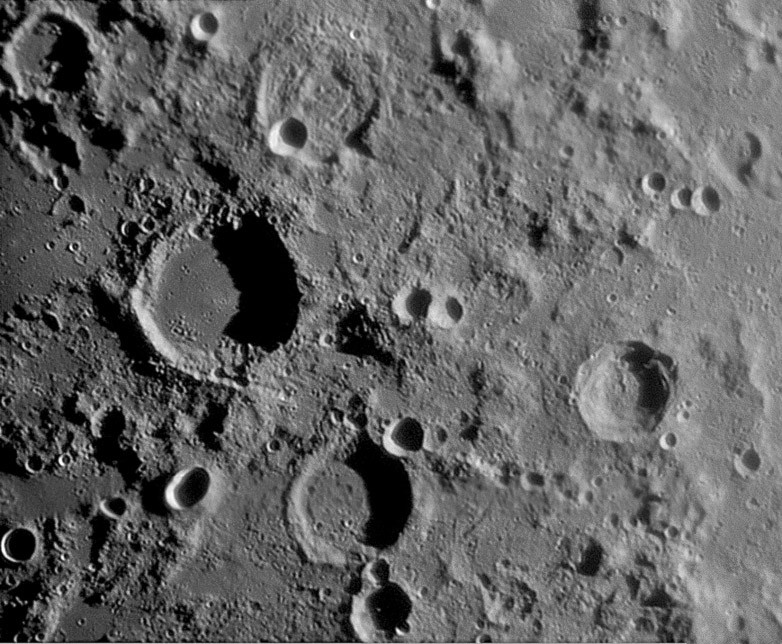|
|
| (3 intermediate revisions by the same user not shown) |
| Line 1: |
Line 1: |
| | __NOTOC__ | | __NOTOC__ |
| | =Splotches and Mounds= | | =Splotches and Mounds= |
| | + | <!-- Start of content --> |
| | <div class="post" id="post-1173"> | | <div class="post" id="post-1173"> |
| | | | |
| Line 6: |
Line 7: |
| | <p>[[File:Abulfeda-area-Jerome.jpg|Abulfeda-area-Jerome.jpg]]<br /> | | <p>[[File:Abulfeda-area-Jerome.jpg|Abulfeda-area-Jerome.jpg]]<br /> |
| | <em>image by [mailto:jeromegrenier@free.fr Jérôme Grenier], Paris, France</em></p> | | <em>image by [mailto:jeromegrenier@free.fr Jérôme Grenier], Paris, France</em></p> |
| − | <p>You might expect that this LPOD will be about the Abulfeda crater chain that slices across the bottom half of this image from Abulfeda (biggest crater), above Almanon, and on toward a low spot in the Altai Scarp (bottom right). But its not. Jérôme’s image captures two kinds of terrain - rough and cratered surfaces dotted with moundy massifs, and very smooth surfaces that lie in some low spaces and sometimes appear to be plastered on top of underlying materials. The moundy massifs are perhaps large ejecta blocks on the backslope of the Altai rim of the Nectaris basin. Two good examples are the blobby mound east of Descartes, and the shadow-casting one east of Abulfeda near the two touching craters (Abulfeda E and an undesignated companion). The smooth spots are more fascinating to me. Notice the four or five smooth areas in the bottom left corner. Near the terminator is a very smooth patch that seems to fill an elongated shallow area. Two similar smoothings are directly south, and two patchs of material appear to be plastered on the surface inside and just west of Almanon. This material, and that flooring Abulfeda, is called the Cayley Formation and is believed to be fluidized ejecta that splashed into place after being thrown 1000+ km from the Imbrium Basin. I don’t understand why such an airmail delivery would so often land in depressions - I would expect it to be scattered on top of any type of surface as the bits west of Almanon are. What is wrong with my expectations? Why am I so uncomfortable with this fluidized ejecta interpretation, 30+ years after the Apollo 16 surprise (basin ejecta rather than lavas) dumped it on us. What do you think?</p> | + | <p>You might expect that this LPOD will be about the Abulfeda crater chain that slices across the bottom half of this image from Abulfeda (biggest crater), above Almanon, and on toward a low spot in the Altai Scarp (bottom right). But it's not. Jérôme’s image captures two kinds of terrain - rough and cratered surfaces dotted with moundy massifs, and very smooth surfaces that lie in some low spaces and sometimes appear to be plastered on top of underlying materials. The moundy massifs are perhaps large ejecta blocks on the backslope of the Altai rim of the Nectaris basin. Two good examples are the blobby mound east of Descartes, and the shadow-casting one east of Abulfeda near the two touching craters (Abulfeda E and an undesignated companion). The smooth spots are more fascinating to me. Notice the four or five smooth areas in the bottom left corner. Near the terminator is a very smooth patch that seems to fill an elongated shallow area. Two similar smoothings are directly south, and two patchs of material appear to be plastered on the surface inside and just west of Almanon. This material, and that flooring Abulfeda, is called the Cayley Formation and is believed to be fluidized ejecta that splashed into place after being thrown 1000+ km from the Imbrium Basin. I don’t understand why such an airmail delivery would so often land in depressions - I would expect it to be scattered on top of any type of surface as the bits west of Almanon are. What is wrong with my expectations? Why am I so uncomfortable with this fluidized ejecta interpretation, 30+ years after the Apollo 16 surprise (basin ejecta rather than lavas) dumped it on us. What do you think?</p> |
| | <p>[mailto:tychocrater@yahoo.com Chuck Wood]</p> | | <p>[mailto:tychocrater@yahoo.com Chuck Wood]</p> |
| | <p><strong>Technical Details:</strong><br /> | | <p><strong>Technical Details:</strong><br /> |
| Line 13: |
Line 14: |
| | Rükl charts 45, 46, 56 & 57.<br /> | | Rükl charts 45, 46, 56 & 57.<br /> |
| | [http://astrosurf.com/grenier/ Jérôme’s website]</p> | | [http://astrosurf.com/grenier/ Jérôme’s website]</p> |
| − | <p><b>Yesterday's LPOD:</b> [[June 8, 2007|History of An Eastern Name]] </p> | + | <p><b>Yesterday's LPOD:</b> [[June 8, 2007|History of an Eastern Name]] </p> |
| | <p><b>Tomorrow's LPOD:</b> [[June 10, 2007|A Rim on the Limb Again]] </p> | | <p><b>Tomorrow's LPOD:</b> [[June 10, 2007|A Rim on the Limb Again]] </p> |
| − | <!-- Removed reference to store page --> | + | <!-- Removed reference to store page 2 --> |
| | </div> | | </div> |
| | + | <!-- End of content --> |
| | {{wiki/ArticleFooter}} | | {{wiki/ArticleFooter}} |




